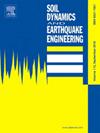层状地基桩基支撑大型(1/15)核安全壳振动台试验研究
IF 4.2
2区 工程技术
Q1 ENGINEERING, GEOLOGICAL
引用次数: 0
摘要
本文通过一系列大型振动台试验,研究了非岩石场地群桩基础核安全壳的地震反应。试验模型为1/15比例核安全壳(外径2.96 m,高5.38 m),采用群桩基础支撑,固定在新研制的大型层状土箱(5m × 5m × 2m)底部。群桩基础由19根直径0.2 m、高1.5 m的桩组成,层状地基由0.75 m厚的砂层和1.05 m厚的粉质粘土层构成。试验在天津大学国家地震工程模拟中心(NFEES)进行,输入运动包括rg1.60、安全评价波和赤赤波,峰值加速度范围为0.1g ~ 1.0g。记录并分析了其破坏现象、动态特性、加速度、位移和应变响应。结果表明,即使在超过安全关闭地震(SL-2)的载荷情况下,安全壳仍能保持其完整性。与刚性基础相比,群桩基础对安全壳具有较好的抗震作用。群桩基础在桩顶处遭受较大的破坏。值得注意的是,外环桩顶的弯矩比内环桩顶的弯矩高约20%。在三向(3D)加载下,与单向(1D)加载相比,安全壳的峰值混凝土拉伸应变增加了约20%,峰值加速度放大系数提高了50%。结果表明,群桩基础可以作为复杂非岩石场地核安全壳的有效可靠基础。本文章由计算机程序翻译,如有差异,请以英文原文为准。
Shaking table test study of large-scale (1/15) nuclear containment vessel supported by pile group foundation in a layered ground
This paper investigated the seismic response of nuclear containment vessel supported by pile group foundation in a non-rock site through a series of large-scale shaking table tests. The test model was 1/15 scaled nuclear containment vessel (outer diameter 2.96 m, height 5.38 m) supported by a pile group foundation, which was fixed at the bottom of the newly developed large-scale laminar soil box (5 m × 5 m × 2 m). The pile group foundation was modeled by 19 piles with diameter of 0.2 m and height of 1.5 m, and the layered ground was represented by 0.75 m thickness sand layer over 1.05 m thickness silty clay layer. The tests were conducted at the National Facility for Earthquake Engineering Simulation (NFEES) of Tianjin University and the input motions included the RG 1.60, safety evaluation wave, and Chi-Chi wave with peak accelerations ranging from 0.1g to 1.0g. The failure phenomenon, dynamic characteristics, acceleration, displacement, and strain responses were recorded and analyzed. Findings reveal that the containment vessel maintains its integrity even under loading cases exceeding safe-shutdown earthquake (SL-2). The pile group foundation exhibits a seismic resistance effect on the containment vessel, compared with the rigid foundation. The pile group foundation sustains significant damage at the pile heads. Notably, the pile heads on the outer ring experience approximately 20 % higher bending moments than those on the inner ring. Under three-directional (3D) loading, the containment vessel exhibits an approximately 20 % rise in peak concrete tensile strain and a 50 % elevation in peak acceleration amplification factor compared with one-directional (1D) loading. The results indicate that the pile group foundation can serve as an effective and reliable foundation for nuclear containment vessel constructed on complex non-rock sites.
求助全文
通过发布文献求助,成功后即可免费获取论文全文。
去求助
来源期刊

Soil Dynamics and Earthquake Engineering
工程技术-地球科学综合
CiteScore
7.50
自引率
15.00%
发文量
446
审稿时长
8 months
期刊介绍:
The journal aims to encourage and enhance the role of mechanics and other disciplines as they relate to earthquake engineering by providing opportunities for the publication of the work of applied mathematicians, engineers and other applied scientists involved in solving problems closely related to the field of earthquake engineering and geotechnical earthquake engineering.
Emphasis is placed on new concepts and techniques, but case histories will also be published if they enhance the presentation and understanding of new technical concepts.
 求助内容:
求助内容: 应助结果提醒方式:
应助结果提醒方式:


